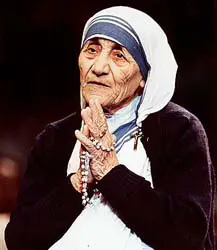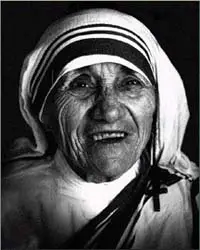Mother Teresa
The woman known as Mother Teresa was born in 1910 in what is now known as the Republic of Macedonia. She came from a comfortable family that were deeply religious and devoted to the Roman Catholic Church, and very committed to helping those less fortunate. This would be the legacy that her family gave to her as Mother Teresa became one of the most well-known and beloved religious members that were devoted to the poor.


She made the decision to leave her family and become a nun at the young age of 18 with the desire to be a teacher. She traveled to Ireland and then later to India for her novitiate period. Once she took her First Profession of Vows, she was sent to Calcutta, India as a teacher at Saint Mary’s High School for Girls that was operated by the Loreto Sisters. The order was dedicated to teaching the girls of some of the poorest Bengali families and it was here that Mother Teresa learned to speak both Hindi and Bengali. Her hopes as a teacher was to help to eliminate the poverty of the girls through education.

By 1937, Mother Teresa took her Final Profession of Vows to a life of chastity, poverty and obedience and it was at that time that, as a nun, she took on the Loreto nun’s title of ‘Mother’. She continued to teach in the school and in 1944 became the school principal and she was loved by many for her kindness and devotion to education.

It was in 1946 that Mother Teresa experienced something that would change her life. While riding on a train from Calcutta for a retreat, she said Christ spoke to her and told her to leave the teaching work that she was doing and work in the Calcutta slums, helping the sickest and poorest people of the city. She said she heard Christ saying: “I want Indian Nuns, Missionaries of Charity, who would be my fire of love amongst the poor, the sick, the dying and the little children. You are I know the most incapable person—weak and sinful but just because you are that—I want to use You for My glory. Wilt thou refuse?”

Her vow of obedience would not allow her to leave her convent without official permission and she spent almost 1 ½ years lobbying to be released. In 1948 she received her local Archbishop’s approval to pursue her new calling and in August, wearing the traditional blue and white sari that she would be known for, she left the convent and headed to Calcutta. She spent six months in basic medical training and then went to the slums to help “the unwanted, the unloved, the uncared for.”


Mother Teresa set up an open-air school and then a home for the dying in an old building that was donated to her. In 1950 she achieved canonical recognition for the Missionaries of Charity as a new congregation. It had only 12 members and most were former students and teachers from the school where she had taught. She and her members continued their efforts in between the 1950’s and 1960’s she established an orphanage, a leper colony, a string of mobile health clinics, a family clinic and a nursing home. Pope Paul VI bestowed the Decree of Praise on the Missionaries of Charity in 1965.

By 1971, Mother Teresa’s work had become internationally known. She opened the first American charity in 1982 and then traveled to the Muslim area of Beirut to help children of both Christian and Muslim faiths. She was invited in 1985 to speak at the United Nations 40th Anniversary General Assembly and while she was there, she also opened a home called ‘Gift of Love’ to help in caring for those that were infected with HIV/AIDS.

Mother Teresa received the Jewel of India award which is the highest honor that an Indian civilian can receive. She also received the Soviet Union’s Gold Medal of the Soviet Peace Committee and in 1979 she was awarded the Nobel Peace Prize for her work “in bringing help to suffering humanity.”

When she passed away in 1997, her Missionaries of Charity had over 4,000 members with thousands as lay volunteers and over 610 foundations that covered 123 countries in all of the seven continents.




